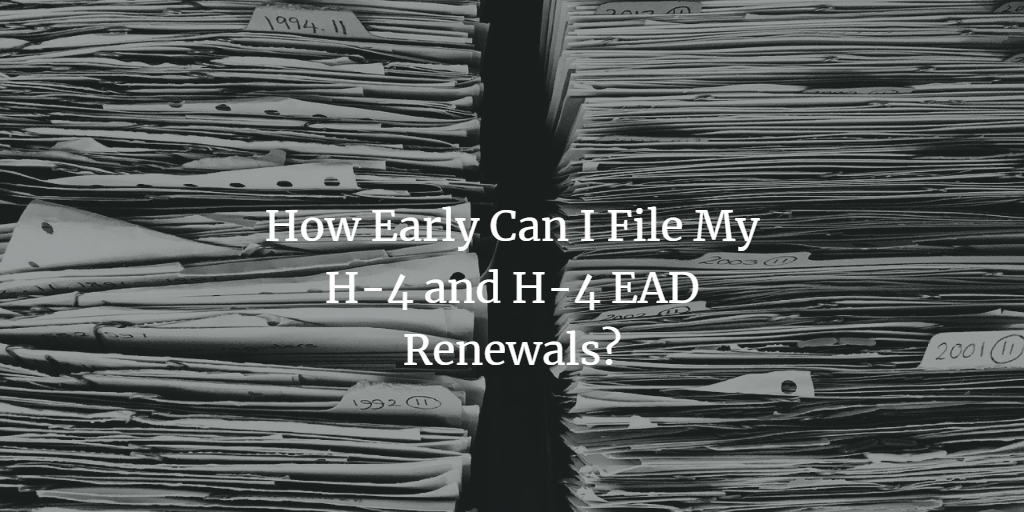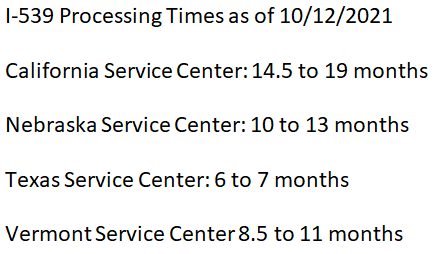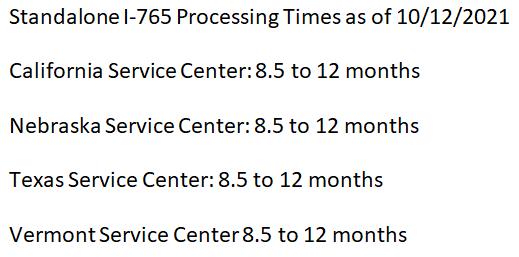
How Early Can I File My H-4 and H-4 EAD Renewals?
Guidance on the USCIS website instructs applicants for H-4 EAD renewals that they “cannot” file for a renewal more than 180 days before the original EAD expires. However, processing times at all four USCIS Service Centers for standalone H-4 EAD renewals are currently listed at 8.5 to 12 months. If renewal applicants cannot file more than 6 months in advance, but processing times exceed 6 months, a gap in employment authorization will result. What’s worse, if concurrently filing the H-4 EAD renewal with an extension of H-4 status on Form I-539, the processing time increases to up to 19 months, depending on Service Center. USCIS will not process the EAD renewal until the request for extension of H-4 status is approved. This can lead to a gap in employment authorization of up to 13 months, even if an individual files the renewal 6 months in advance.

.
Given the long processing times, can applicants file more than 6 months in advance to avoid a gap in employment authorization?
For those filing the H-4 and EAD renewal along with a spouse’s H-1B extension, the applications can generally be filed no more than 6 months in advance because the I-129 petition cannot be filed more than 6 months before the requested start date of the new H-1B period of employment.
However, if an H-1B extension has already been granted, such as in the situation of a change of employer or amendment, it may make sense to file the H-4 and EAD renewal more than 6 months prior to the expiration. The regulation that created the H-4 EAD addressed the potential for gaps in employment authorization and recommended “timely” filing of applications: “To avoid any potential gaps in employment authorization when seeking an extension of employment authorization, DHS recommends that the H–4 dependent spouse timely file all necessary applications. DHS’s policy to permit concurrent filing of Forms I–539, I–129, and I–765 should also help H–4 dependent spouses avoid gaps in employment authorization.”
Further, USCIS has posted a guide for nonimmigrants, “How do I extend my nonimmigrant stay in the United States?” In addressing when dependents should file Form I-539 and how long will it take to process the application, USCIS states: “Our processing times can vary. You may check our Web site, www.uscis.gov, for our current processing times. We suggest you file at least 45 days before your stay expires.”
Based on current processing times, if filing more than 6 months in advance, by the time USCIS gets around to actually adjudicating the application, the EAD will likely be close to expiring if not already expired. The fact that it was filed more than 6 months prior should be irrelevant. USCIS should issue the renewal EAD from the date of approval to the date the H-1B and H-4 status expire. While a few requests for evidence have been reported asking for an explanation regarding the early filing, there have been no reports of denials of H-4 EAD renewals due to filing more than 6 months in advance.
By: Emily Neumann
Emily Neumann is Managing Partner at Reddy Neumann Brown PC with 15 years of experience practicing US immigration law providing services to U.S. businesses and multinational corporations. Emily has been quoted in Bloomberg Law, U.S. News & World Report, Inside Higher Ed, and The Times of India on various hot topics in immigration. She is a member of the American Immigration Lawyers Association and Society for Human Resource Management.


